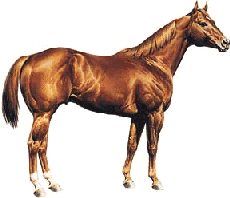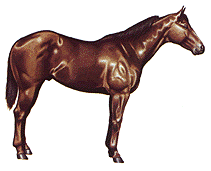|
|
American Quarter Horse |
|
|
American Quarter Horse |
 Known today as the world's most versatile horse, the Quarter Horse got his start racing in colonial America. In the 1600s, villagers would gather to witness a race between two horses.
Little more than 20 seconds later, the time it took the horses to run the quarter mile down the
village street, a new champion was named.
Known today as the world's most versatile horse, the Quarter Horse got his start racing in colonial America. In the 1600s, villagers would gather to witness a race between two horses.
Little more than 20 seconds later, the time it took the horses to run the quarter mile down the
village street, a new champion was named.
The origin of the Quarter Horse goes back even further. Foundation Quarter Horse stock originated from Arab, Barb, and Turk breeds shipped to the Americas by Spanish explorers and traders. Selected stallions from these herds were crossed with mares which arrived from England in 1611. The cross produced a compact, heavily muscled horse which could run short distances faster than any horse ever.
As the country grew and more Englishmen arrived, they replaced the quarter mile races with traditional longer distance races not particularly suited to the stocky QH. With decreased interest in short distance races, the QH began change from sporting horses to working horses.
When pioneers moved westward, so did the QH. In the 1800s, vast cattle ranches began stretching across the plains and there was where the breed established its reputation.
Just as the breed's ranch reputation reached its peak, at the approach of the 1900s, technological changes and settlement of western states caused a decline in the number and size of the massive cattle ranches. Railways stretched farther west providing transportation of cattle to market and eliminating the need for long distance cattle drives. Other advancements permitted cutbacks in the numbers of employees and horses needed for cattle operations.
A group of ranchers became concerned that the QH breed might not survive unless something was done. So in 1939 at the Southwestern Exposition and Fat Stock Show in Fort Worth, Texas, a handful of breeders met to lay groundwork for an organization to represent and preserve the QH. On March 15, 1940, representatives from several states and the Republic of Mexico met in Fort Worth to formally establish a registry known as the American Quarter Horse Association (AQHA).
With the formation of the AQHA, founders and early members believed in a bright future for the versatile QH, and hoped to spread the news of the breed's attributes, its abilities and achievements.
 Quarter Horse founders determined that the Grand Champion Stallion at the 1941 SW
Exposition and Fat Stock Show in Fort Worth would receive number one in the registry. Many of
the Southwest's top ranches entered their prized stallions in the competition, but it was Wimpy,
owned by the King Ranch of Kingsville, Texas, who got top honors.
Quarter Horse founders determined that the Grand Champion Stallion at the 1941 SW
Exposition and Fat Stock Show in Fort Worth would receive number one in the registry. Many of
the Southwest's top ranches entered their prized stallions in the competition, but it was Wimpy,
owned by the King Ranch of Kingsville, Texas, who got top honors.
Sired by Solis and out of the mare Panda, Wimpy's bloodlines traced back to Old Sorrel, Hickory Bill and Peter McCue, three of the most famed foundation sires of the modern QH. Foaled in 1935 on the King Ranch, Wimpy became one of the most noted Quarter Horses in the world. The stallion died in 1959, a sculpture of him is located at the entrance to the AQHA headquarters in Amarillo, Texas.
Quarter Horses compete in a variety of classes to be eligible to win the most sought after title of World Champion. The Annual World Championship show hosts top QHs vying for championship titles, world show trophies and cash prizes in halter and performance events. Only the best are able to compete, as each horse must qualify by earning a predetermined number of points.
Quarter Horses are shown in the following classes, and excel in more areas of competition than any other breed. Halter (judged on correct structure, breed type, muscling, soundness and manner in which they travel), Western Pleasure, Trail, Barrel Racing, Pole Bending, Western Riding (different than Western Pleasure), Reining, Cutting, Working Cow Horse, Calf Roping, Team Roping, Hunter Under Saddle, Hunter Hack (jumps 2 fences a certain height, then shown at walk, trot and canter), Working Hunter (how graceful and comfortably he jumps barriers on a cross-country course), jumping (how high, with least faults and fastest time), Pleasure Driving, Cutter and Chariot Racing, Western Horsemanship (youth and amateur division judging rider's ability, not actual performance of the horse), Hunt Seat Equitation (another rider's ability to ride), Showmanship at Halter, Breakaway Roping, Stake Race.
In 1940, QH racing made a comeback, and today it is an over $50 million per year enterprise. Distances are 220 yards to 870 yards, with 440 yards, the classic 1/4 mile being the most popular. The fastest time ever recorded for the 1/4 mile is 21.02 seconds, meaning a fast 46 miles an hour for a horse.
To see this versatile breed, you can watch a program on TV called "America's Horse," Produced by the AQHA, and airs nationwide on cable systems via ESPN. It features top QH events monthly.
 For more information of legendary Quarter Horse stallions and mares who gained fame in
the early days of the AQHA, check out the newest books, "Legends," and "Legends II." Thanks to
the AQHA, P.O. Box 200, Amarillo, TX 79168, for this insight on the American Quarter Horse.
For more information of legendary Quarter Horse stallions and mares who gained fame in
the early days of the AQHA, check out the newest books, "Legends," and "Legends II." Thanks to
the AQHA, P.O. Box 200, Amarillo, TX 79168, for this insight on the American Quarter Horse.
For more information on the American Quarter Horse, visit:


|
© 1997-2007
NW Breyer Horse Club & Refiner of Gold Creations Equinealities in place since 1997, Section in place 2001, Updated 3/13/2007 |



|
| ||

|
|||||